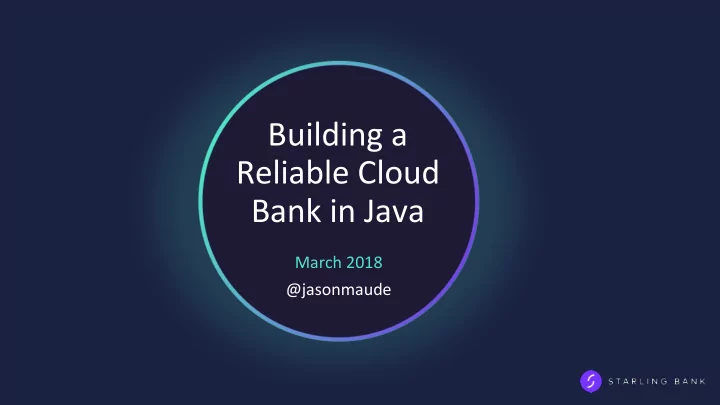

Building a Reliable Cloud Bank in Java March 2018 @jasonmaude
18th June 2012
19th June 2012
20th June 2012
10th July 2012
How did this happen?
The people accepted the possibility of failure The software didn’t
We built a bank in a year 2014 Founded by Anne Boden June 2014 Kick-off with Regulators Sept 2015 Technical prototypes Jan 2016 Raise $70m – start build July 2016 Banking licence & first account in production October 2016 Mastercard debit cards November 2016 Alpha testing mobile app December 2016 Direct debits live January 2017 Faster payments live February 2017 Launched beta testing program May 2017 Public App Store Launch July 2017 ApplePay September 2017 AndroidPay
Starling Bank today Tech start-up with a banking licence 100% cloud-based, mobile-only Mastercard debit card DDs and faster payments Location-enriched transaction feed ApplePay, GooglePay, FitBitPay... Spending insights Granular card control Open APIs & developer platform
Is Java cutting edge?
Self-contained systems http://scs-architecture.org
Starling as self-contained systems •all services have their own RDS instance •inter-service comms is generally async •mobile layer integrates data from different services •no start-up order dependencies
Not pure SCS •we’re mobile-first (and API-first!) – web is secondary •services not owned by single team •our services have REST APIs but no internal web UI •one key area with sync interaction (balance allocation)
Self-Contained Systems
L.O.A.S.C.T.T.D.I.T.T.E.O. (lots of autonomous services continually trying to do idempotent things to each other)
DITTO architecture (do idempotent things to others)
DITTO architecture •do everything at least once and at most once •async + idempotence + retry •each service constantly working towards correctness •often achieve idempotence by immutability •no distributed transactions •don’t trust other services
customer payment bank POST Make a payment 201 Created {uuid} {PUT {uuid 202 Accepted {PUT {uuid 202 Accepted
POST 201 Created {uuid} {PUT {uuid ”Idempotence = “at most once retry ”Retry provides “at least once {PUT {uuid 202 Accepted {PUT {uuid retry {PUT {uuid 202 Accepted
Recoverable Command •What do I need to do? •How do I record that I’ve done it?
Recoverable Command
Catch-up Processor •Which data items should I attempt to re-process? •What command should I use to re-process them?
Catch-Up Processor
Testing •starbot chat-ops exposes • starbot kill • starbot kill all •available to all developers
Instance termination is safe •single stateless service per instance •if ever a server is in doubtful state, kill it •chat-ops slack bot •rolling deployments by termination (not quick but safe)
Continual delivery of back-end •continual deployment to non-prod, sign-off into prod •auto build, dockerise, test, scan, deploy < 1h •code released to production up to 5 times a day
We have turned 2-speed IT on its head •traditional banks operate: • legacy backends that move at glacial pace • and try to iterate the customer experience faster •we release the backend at 10x the rate of the mobile apps • 1-5 backend software releases per day • 1-2 infrastructure releases per day • mobile apps released weekly or fortnightly
A “take ownership” ceremony • all engineers explicitly bless their commits in slack • everyone knows the release is imminent • everyone knows when their changes go out • everyone gets a last ditch “OMG” opportunity • everyone asserts their change is “good for prod”
The “rolling” giphy • our auditors loved this one • yes it’s in our release documentation • clear signal in engineering channel that is release in progress
… and if something goes wrong...
Case Study •a failed db upgrade locked the db in notification service •customer service kept trying to send requests to notification •the queue in customer filled up, meaning that other requests were denied •problem was located, instances of customer could be regularly recycled until the problem was fixed •once the problem was fixed all the work due in notification was performed as required
… but why Java? •exceptions are noisy and difficult to ignore •integrations with legacy third parties (SOAP etc) •lightweight (if you cut down on your dependencies) •reliable ecosystem (user base, job market, etc)
… and finally: some important takeaways
Give EVERYTHING a UUID
It’s not just the hardware that can fail
Cherish your bad data
You can do anything you can undo
For more of Starling Bank see Yann and Teresa on Tuesday - 17:25 (Next Gen Bank track)
Thank You! https://developer.starlingbank.co m Check out the Starling Developer Podcast!
Recommend
More recommend